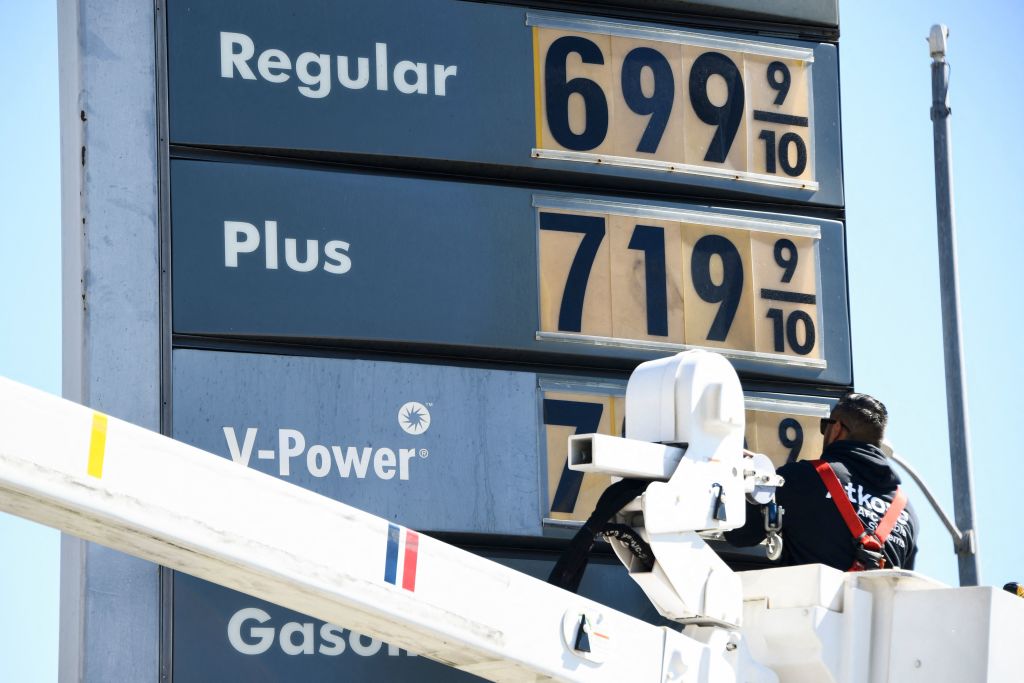When news arrived that the nation’s real gross domestic product (GDP) declined in the first quarter, words like recession and stagflation immediately gained currency. It had long been clear that the post-Covid recovery was slowing, but such characterizations are nonetheless misplaced, at least for the moment. The quarter’s decline was more a reflection of technical matters than of economic fundamentals. Figures for the spring and summer quarters will likely show a return to growth. Still, the buzz about recession and stagflation is warranted, because not too far out on the horizon, say 12 to 18 months, recession or stagnation or both are likely.
Recession is commonly defined as two consecutive quarters of declining real GDP. More rigorous circles at the National Bureau of Economic Research (NBER), where economists identify and date recessions, use more complex and subtle benchmarks. But for most people, two quarters of decline serves as a reasonable measure. Stagflation, however, has less academic and journalistic specificity. A working definition is a stalled or declining economy that nonetheless suffers inflationary pressure—stagnation and inflation both. Vague as the definition is, it has much analytical significance.
The word first came into wide use during the great inflation of the 1970s and early 1980s. At the time, economists described reality in terms of what they called the “Phillips Curve.” It held that inflation occurs when the economy fully employs its labor and other productive resources, and when there is slack, price pressures abate. Accordingly, practitioners expected a tradeoff between inflation and unemployment.
But during the 1970 and 1980s, inflation raged seemingly undisturbed by several recessions and other periods of halting growth. To deal with the clear inadequacies of the Phillips Curve, economists, policy makers, and businesspeople came to recognize how long periods of price pressure create a kind of inflationary psychology among people. Expecting the cost of living to rise, workers demand wage hikes, which managements grant, even if unemployment is high, because they are confident in getting price increases to more than make up the difference for the bottom line. Because such expectations allowed inflation to percolate even in periods of high unemployment, the word stagflation became common on financial pages.
It is beginning to look as though such inflation expectations are taking hold in the United States today. Polls uniformly show Americans worried about continuing rapid increases in living costs. Wage growth has accelerated beyond historical norms but still fails to keep up with price increases. No matter how spin doctors in Washington care to frame the matter, Americans are aware, intuitively at least, that inflation is embedded in the economy.
And well they should anticipate persistent inflation, for today’s price pressures have deep fundamental roots. Seeds of today’s inflation problem were planted more than a decade ago in the financial crisis of 2008 and 2009 and the great recession that it caused. To deal with the exigencies of that situation, the Fed drove short-term interest rates down to zero and otherwise poured liquidity directly into the economy by buying securities outright in financial markets, what central bankers refer to as “quantitative easing.” At the same time, the Obama administration tried to ward off the ensuing recession with massively stimulative fiscal policies that greatly enlarged federal budget deficits.
Though such policies were justifiable in the circumstance, the inflationary mistake was how, contrary to past practice, the Fed and the administration persisted in such policies even as the economy began to recover. Monetary policy continued its quantitative easing and kept interest rates near zero for years, while the federal government continued to run historically large deficits. It was not until 2014—five years into the recovery—that policy began to moderate and then only gradually. After 2016, President Trump made fiscal policy even more stimulative, and Biden built on that pattern, first to deal with the pandemic but with other large spending initiatives. The Fed returned to its extreme stimulative policies in 2019, well before the pandemic, and continued in that pattern until just a few weeks ago.
Whatever the intent of the authorities or the immediate needs at each moment along the way, the persistence of these policies amounted to financing government by printing money. During this time the Fed created new money to buy some $5 trillion in treasury debt, some $3 trillion in just the last couple of years. This behavior is a classic prescription for inflation and should make it clear that contrary to Washington’s repeated assertions, price pressures will not lift easily or soon, and certainly not of their own accord. Though the administration only bears part of the blame for this fundamental inflationary pattern, Washington’s refusal to recognize the problem for more than a year after price pressures became evident has fostered inflation expectations by undermining people’s confidence in Washington’s ability to acknowledge reality, much less to bring the problem under control.
It is hard to credit Washington’s behavior during these past twelve months or so. Fed Chairman Jerome Powell is surely aware of the inflationary nature of past policies, as is Treasury Secretary Janet Yellen. Yet for months both insisted that the inflation was “transitory.” Policy remained as expansive as ever. The Fed held interest rates near zero and actively pursued quantitative easing. Yellen went along with President Biden to press for additional fiscal programs that would widen deficits. All blamed inflation on post-pandemic supply-chain problems that they were sure would lift soon. These problems no doubt contributed to the price pressures, but they were peripheral to inflation’s underlying cause. It was not until early this year that the Fed “retired” the word “transitory” and began to reconsider its policy posture. All the White House has done so far is switch the blame from supply chains to Vladimir Putin.
These months of denial squandered precious time when judicious policy adjustments might have blunted inflationary pressures and forestalled the development of inflationary expectations. Now anti-inflationary efforts face a much heavier lift. The Fed has at least begun to make the policy turn. It recently reversed the quantitative easing program, aiming now to withdraw liquidity from markets by selling some of the hoard of bonds acquired previously, and it has begun gradually to increase interest rates. To deal with this inflation, the Fed will have sell securities more aggressively and raise interest rates more forcefully. Consider that short-term rates, even after the Fed’s latest move, still stand at only 0.5 percent. With today’s inflation, a borrower will repay his or her lender in dollars worth 8.5 percent less in real terms. That is a much bigger number than the 0.5 percent earned by the lender. Effectively, all borrowers (the U.S. government included) have the use of the money for a year and gains 8.0 percent in real terms. This is far from the kind of restrictive monetary policy needed to counter inflation.
Conceivably, the Fed could make the required moves deftly enough to avoid shocking markets and precipitating a recession, a so-called “soft landing.” History suggests, however, that such dexterity is unlikely, and that anti-inflation monetary actions will create a recession, especially since inflationary psychologies have now taken hold. A policy-induced recession will likely arrive late this year or early in 2023. But even if the Fed, fearful of such a result, pulls its punches and fails to act forcefully enough, the nation will still likely suffer a period of stagnation and recession. Left unchecked, inflation itself would create sufficient economic distortions to create such ills.
As in the past, inadequately checked, inflation would in fact create deep and long-lasting economic damage, much worse than any restrictive monetary policy would. A loss of confidence in Washington’s ability to manage things would siffle business’ investment spending, which would also suffer from the uncertainties imposed by unpredictable cost increases. A paucity of investment projects would halt gains in efficiency and productive potential. Workers, even if able to secure wage hikes, would still struggle to keep up with rapidly rising living costs and cut back on their real spending accordingly. This year, an atypically large rise in wages of 3.5 to 4.5 percent still trails inflation by a wide margin. Rapid inflation also would also erode the real value of dollar-denominated assets, like stocks and bonds, causing a retreat in financial markets that would further discourage investments in real productive capacities. Meanwhile, price pressures would redirect any remaining investment monies away from productive projects and into inflation hedges, such as art and real estate speculation.
While anti-inflation policies are likely to bring on recession, the alternative—letting inflation weaken the prospect of economic growth—would be worse. A downturn in response to monetary restraint may come sooner than the economic trouble of doing too little to slow inflationary momentum, but it would be shorter and less severe, with fewer job losses and a quicker turn to recovery. An insufficient policy reaction would not only doom the country to suffer with inflation longer but, as should be clear, it would cause more fundamental and lasting economic damage. The economic weakness reported for this year’s first quarter may be a false signal, but if it instills a measure of sobriety into policy making, it will serve the nation well.




